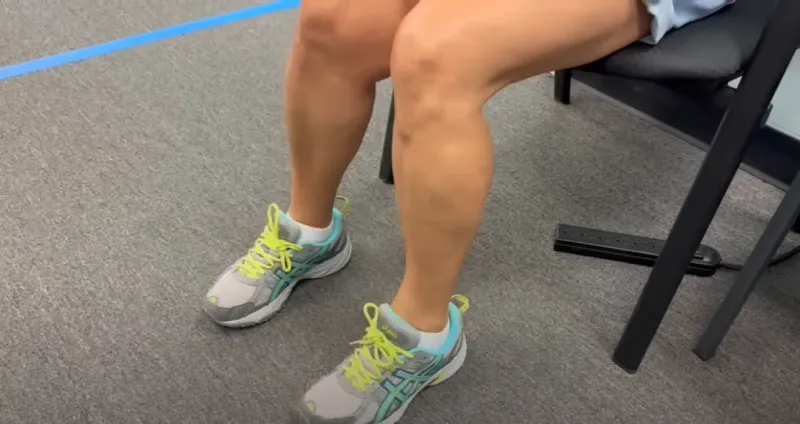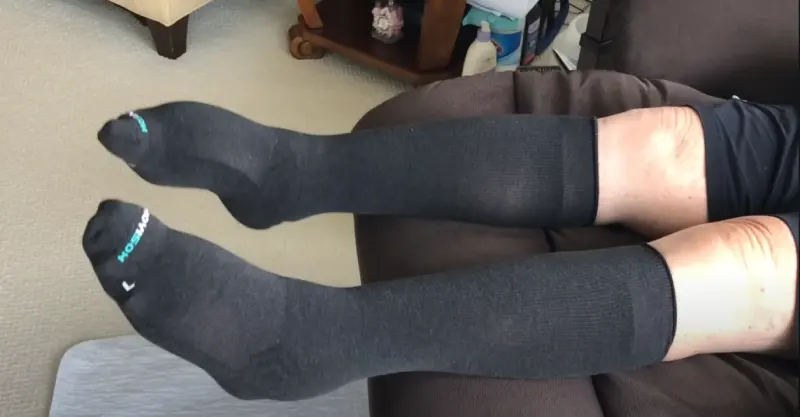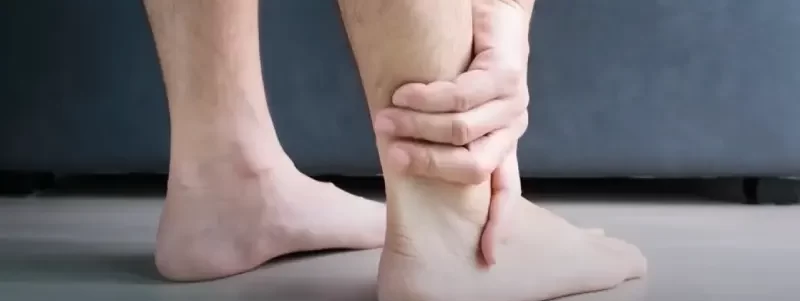Peripheral edema is characterized by leg swelling. Fluid retention in leg tissues can result from problems with the venous circulation system, lymphatic system, or kidneys. Intense activity and increased blood flow to leg muscles can cause fluid leakage and swelling.
Elevate the legs above the heart post-ride to reduce leg swelling due to cycling. Maintain exercise and hydration, and wear compression socks. Try a low-salt diet, manage electrolytes, ice, massage, and eat magnesium-rich foods. Perform exercises like walking in place or leg lifts.
In this blog post, we will explore the 7 Proactive Tips, 5 Causes, and 5 Exercises for Reducing leg swelling caused by cycling.
How To Reduce Swelling In Legs Due Cycling: 7 Proactive Tips

Enjoying the outdoors and staying fit are excellent reasons to ride a bicycle. It can sometimes lead to uncomfortable swelling in the legs. Luckily, there are steps you can take to prevent this. One of the most effective methods is to ensure your bike fits you properly and you maintain the correct posture while riding.
Optimizing Bike Fit and Posture
Getting your bike to fit you like a glove is key to avoiding leg swelling. Here’s why and how:
The Need for Professional Bike Fitting
- Ensure Correct Posture: A professional bike fitting helps you sit and ride in the best way for your body, which means less strain on your legs.
- Reduce Strain: When your bike fits you perfectly, it reduces unnecessary strain on your legs. This helps prevent swelling caused by overworking or incorrect leg positioning.
Making the Right Adjustments
- Saddle Height: It’s crucial to adjust the saddle height. If it’s too high or too low, your legs won’t be at the right angle when you pedal, which can mess with your circulation and lead to swelling.
- Handlebar Positioning: The position of your handlebars affects your overall posture on the bike. Handlebars that are too low or too high force you into an unnatural position, which can again impact circulation.
Nutrition and Hydration Strategies to Prevent Leg Swelling

Staying hydrated and eating right is good for overall health and crucial for preventing uncomfortable leg swelling after cycling. Let’s explore why drinking enough water and choosing the right foods can help keep those legs feeling good.
The Power of Staying Hydrated
Water is like a superhero for our bodies, especially for cyclists. Here’s how it helps prevent leg swelling:
- Fights Fluid Retention: It might sound strange, but water prevents your body from absorbing extra fluid. When you’re well-hydrated, your body trusts that it will keep getting the water it needs, so it lets go of any extra water it’s storing.
- Keeps Circulation Smooth: Water helps keep your blood flowing smoothly. Good circulation means less chance of swelling because your body can move fluids around and out of your legs more easily.
Nutritional Tips to Keep Swelling at Bay
What you eat can also impact swelling in your legs. Here are some food-related tips to help:
- Cut Down on Salt: Overeating salt can cause your body to hold on to water, leading to swelling. Try to eat fewer salty snacks and meals with electrolytes.
- Potassium-Rich Foods Are Your Friends: Foods high in potassium, like bananas, spinach, and avocados, can help balance out the effects of salt and keep swelling down.
- Protein is essential: Getting enough protein is key for healthy muscles and can help manage fluid balance. Lean meats, beans, and tofu are great options.
- Magnesium-rich foods: Your painful problem may be solved by adding magnesium-rich foods to your diet. The best foods to consume magnesium are nuts and seeds (almonds, cashews, flaxseed, peanuts, and pumpkin seeds), legumes (black beans, lima beans), fiber-rich whole grains (quinoa), low-fat dairy products (milk, yogurt), and greens (spinach).
Step-by-Step Elevation and Compression Techniques

It’s common for cyclists to experience swelling in their legs after a long ride. The right post-ride care, such as elevation and compression techniques. A medical-grade compression stocking reduces swelling and improves blood flow in your legs by applying specific pressure. Let’s explore how these methods work and how they can help you recover routine.
How to Properly Elevate Your Legs
- Find a Comfortable Place: Lie down on a flat surface, such as your bed or a sofa, where you can easily relax.
- Apply Ice: Ice your foot every for up to 20 minutes at a time throughout the day.
- Lift Your Legs: Use pillows, cushions, or rolled-up towels to elevate your legs above the level of your heart. The aim is to get them as high as comfortably possible.
- Take Your Time: Elevate your legs for 15 to 30 minutes. This is an excellent time to relax. You can listen to music, read, or enjoy a moment of stillness.
Using Compression Gear for Recovery
Compression gear is another effective tool for managing leg swelling. Here’s how it helps:
- Enhances Blood Flow: Compression socks or sleeves apply gentle pressure to your legs, helping to improve blood flow.
- Supports Muscle Recovery: Compression gear improves circulation, removes waste from the muscles, and thus speeds up recovery.
- Reduces Swelling: With better circulation and muscle support, compression gear can help prevent and reduce swelling.
Recommendations for Compression Gear:
- Choose the Right Fit: Make sure your compression gear fits snugly but isn’t too tight. It should feel supportive without causing discomfort.
- Wear Post-Ride: Wear your compression socks or sleeves after your ride, especially if you plan to sit or stand for extended periods.
- Consider Quality: Invest in high-quality compression gear designed specifically for athletes or cyclists for the best results.
Leg Swelling In Cyclists: 6 Causes
some cyclists may notice their legs swelling after long rides. This can be uncomfortable and affect your cycling performance. Let’s dive into why this happens and what factors contribute to leg swelling in cyclists.
Peripheral Edema: The Connection to Cycling
Fluid builds up in your legs’ tissues when you have peripheral edema, causing them to swell. Spending a lot of time on a bike, especially on long rides, can slow down blood flow in your legs, leading to fluid buildup.
Nephrotic Edema
Damage to the small filtering units of the kidneys can cause nephrotic syndrome, showed by decreased blood albumin levels and increased urine levels. This disparity can lead to fluid retention, causing leg swelling around the ankles and feet.
Hypoproteinemic Edema
Catabolic Metabolism occurs when the body breaks down muscle for energy, which can happen during ultra-distance cycling. This process can lower the protein levels in your blood, making it harder for your body to prevent fluid from building up in your legs.
Cortisol Production: The Role of Stress Hormones
Stress and hormones: Intense or prolonged cycling can increase stress hormones like cortisol in the body. When cortisol levels are high, the body holds on to more water, leading to swelling.
Weight-Bearing Activities: How They Affect Swelling
Cycling is considered a non-weight-bearing activity because your body doesn’t directly support your weight (like it does when walking or running).
Non-weight-bearing activities like cycling can reduce the risk of swelling in your legs compared to weight-bearing activities. Prolonged sitting in one position on your bike can still cause fluid to build up.
Mechanical Factors: Bike Setup and Gear Selection
How well your bike fits you can significantly impact your leg health. A poorly fitted bike can cause poor leg circulation, leading to swelling. Using the right gear can help manage how hard your legs work. If you’re constantly pedaling hard without enough rest, it can strain your legs and contribute to swelling.
To Reduce Swelling In Legs From Cycling: 5 Exercises

Keeping fit with cycling is great but can sometimes lead to leg swelling. To combat this, incorporating targeted leg exercises into your routine can make a big difference. These exercises improve circulation and strengthen the muscles supporting your cycling endeavors. Let’s explore some effective workouts, including the benefits of cycling and swimming and simple at-home exercises to promote better circulation.
Benefits of Cycling and Swimming
Believe it or not, cycling and swimming are excellent activities for managing and preventing leg swelling. Here’s why:
Cycling With Stationary Bike
Consider a relaxing cycling session focusing on endurance and maintaining a higher cadence to minimize muscle fatigue. Starting with a 30-minute short ride can help build stamina and comfort.
- Improves Muscle Endurance: Regular cycling strengthens leg muscles, supporting veins in pumping blood back to the heart.
- Boosts Circulation: The pedaling action encourages better blood flow, helping to reduce swelling and fluid accumulation.
Swimming
- Low-Impact Exercise: Swimming provides good joint support and is great for those who need a break from high-impact activities.
- Full-Body Workout: It engages multiple muscle groups, promoting overall circulation and reducing the risk of swelling.
At-Home Exercises for Better Circulation
You don’t always need a gym or pool to keep your legs in shape. Here are three simple exercises you can do at home to help improve circulation:
Leg Lifts
- How to Do It: Lie on your back while lifting one leg at a time, keeping it as straight as possible. Lower it back down after a few seconds. Do the same with the other leg.
- Benefits: Strengthens leg muscles and improves blood flow.
Ankle Circles
- How to Do It: Sit or lie down and extend one leg. Make a circular motion with your foot, first clockwise, then counterclockwise. Switch legs and repeat.
- Benefits: Enhances ankle flexibility and stimulates blood circulation in the lower legs.
Calf Raises
The calf muscles play a crucial role in reducing leg swelling by pumping blood back into the heart.
- How to Do It: Stand up straight, then slowly lift your heels until you stand on your toes. Hold for a moment, then slowly lower back down.
- Benefits: Strengthens the calf muscles and boosts blood flow from the legs to the heart.
Leg Massage

The most common techniques for reducing swelling include effleurage, deep strokes, and lymphatic drainage. Press the swollen area using flattened hands and fingers for 10 to 15 minutes. Pressure helps move fluid out of that area.
When to Seek Professional Help for Leg Swelling
While cycling is a great exercise, be sure to listen to your body, especially regarding leg swelling. Simple home remedies can often help but seek professional advice when necessary. Knowing when to get help and treatments is vital for your well-being.
Identifying Signs for Professional Consultation
Leg swelling can sometimes show a more serious underlying condition. Here are key signs it’s time to consult a healthcare provider:
- Persistent Swelling: If your legs remain swollen for long periods or the swelling does not decrease with rest, elevation, or other remedies.
- Pain and Discomfort: Swelling accompanied by pain, discomfort, or heaviness in the legs that interferes with your daily activities.
- One Leg Swollen: If only one leg is affected, it could be a sign of a deep vein thrombosis (DVT), a blood clot requiring immediate attention.
- Skin Changes: Changes in the color of your skin, such as redness or a warm feeling in the swollen area, can indicate inflammation or infection.
- Shortness of Breath: Shortness of breath, leg swelling, and chest pain could suggest more severe cardiovascular issues.
Conclusion
Presenting a cyclist’s roadmap to overcoming leg swelling. Start by fine-tuning your bike fit and posture, keeping hydrated, eating well, and pampering your hardworking legs with sleek compression gear.
Infuse targeted exercises to maintain optimal blood circulation. Embrace a holistic approach to your cycling well-being. Each pedal should spark joy, not discomfort.
Implement these tactics to manage and prevent leg swelling, ensuring a smoother, more delightful riding adventure. Here’s to countless blissful miles and enduring passion for this beloved sport. Keep pedaling.
FAQs
Does Heat Help to Reduce Leg Swelling?
Regular movement, effective weight management, and physical activity can help prevent heat edema. Although the allure of a hot bath, sauna visit, or using a hot water bottle or heating pad on your legs may be strong, heat therapy might exacerbate leg swelling.
What Vitamins Are Good For Edema In The Legs?
Vitamin B6, known as pyridoxine, is believed to assist with mild fluid retention. Rich sources of vitamin B6 encompass brown rice and red meat. Vitamin B5, or pantothenic acid, along with calcium and vitamin D, aid the body in flushing out surplus fluids. Enhance your daily diet with fresh fruits and low-fat dairy products.


